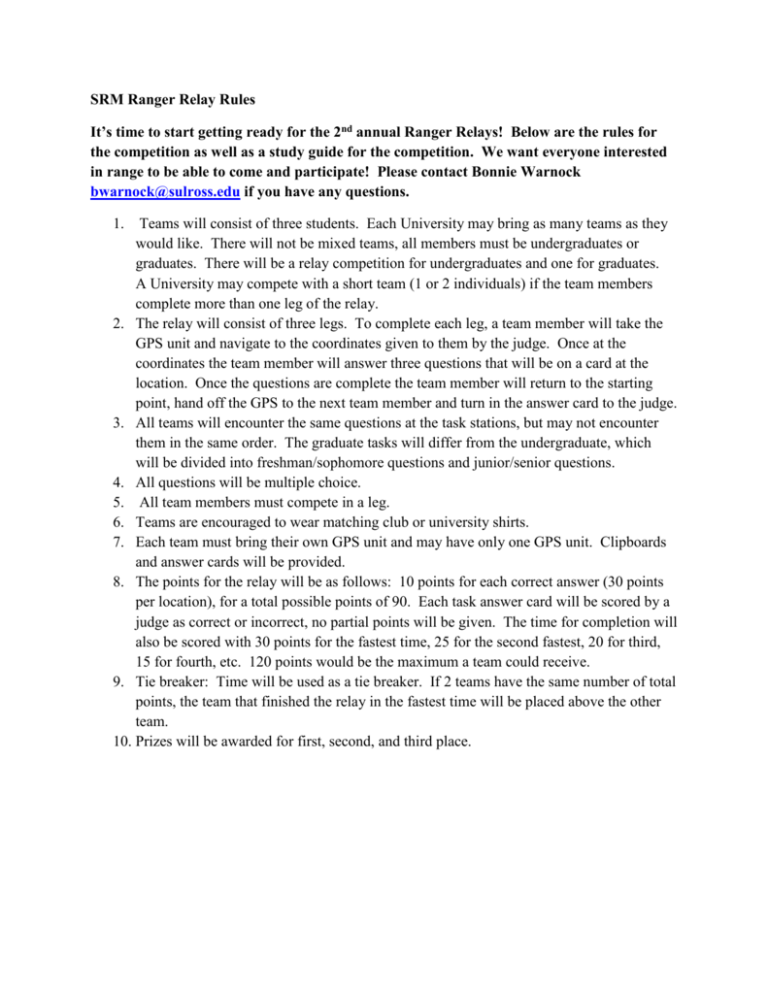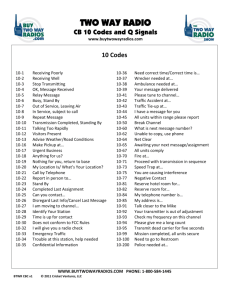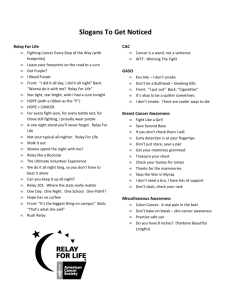SRM Ranger Relay Rules It's time to start getting ready for the 2nd
advertisement

SRM Ranger Relay Rules It’s time to start getting ready for the 2nd annual Ranger Relays! Below are the rules for the competition as well as a study guide for the competition. We want everyone interested in range to be able to come and participate! Please contact Bonnie Warnock bwarnock@sulross.edu if you have any questions. 1. Teams will consist of three students. Each University may bring as many teams as they would like. There will not be mixed teams, all members must be undergraduates or graduates. There will be a relay competition for undergraduates and one for graduates. A University may compete with a short team (1 or 2 individuals) if the team members complete more than one leg of the relay. 2. The relay will consist of three legs. To complete each leg, a team member will take the GPS unit and navigate to the coordinates given to them by the judge. Once at the coordinates the team member will answer three questions that will be on a card at the location. Once the questions are complete the team member will return to the starting point, hand off the GPS to the next team member and turn in the answer card to the judge. 3. All teams will encounter the same questions at the task stations, but may not encounter them in the same order. The graduate tasks will differ from the undergraduate, which will be divided into freshman/sophomore questions and junior/senior questions. 4. All questions will be multiple choice. 5. All team members must compete in a leg. 6. Teams are encouraged to wear matching club or university shirts. 7. Each team must bring their own GPS unit and may have only one GPS unit. Clipboards and answer cards will be provided. 8. The points for the relay will be as follows: 10 points for each correct answer (30 points per location), for a total possible points of 90. Each task answer card will be scored by a judge as correct or incorrect, no partial points will be given. The time for completion will also be scored with 30 points for the fastest time, 25 for the second fastest, 20 for third, 15 for fourth, etc. 120 points would be the maximum a team could receive. 9. Tie breaker: Time will be used as a tie breaker. If 2 teams have the same number of total points, the team that finished the relay in the fastest time will be placed above the other team. 10. Prizes will be awarded for first, second, and third place. How to prepare for the relay (A short study and prep guide) The relay is designed to test basic range management skills. The questions will be tied to the knowledge level of the participant (Graduate students and undergraduate students will be answering different questions). Questions will be tied to the location of the meeting. What to study: 1. General Range Management principles. Range Management: Principles and Practices by Holecheck, Pieper and Herbel is a great resource for preparing. All students competing in the contest will need to know these basic principles. Questions that cover these principles such as the calculation of stocking rate, factors that influence runoff, and considerations for brush or weed control will be fair game for the contest. 2. General Range Inventory techniques. Students should know how to use the following techniques: quadrat, point step, and line intercept. 3. Location Information. The SRM meeting will be held in Gillespie county. Students should go to Web Soil Survey websoilsurvey.nrcs.usda.gov and ESIS esis.sc.egov.usda.gov. Questions will cover the following soil series: Tarrant, Tarpley, Oakalla, Eckrant, Brackett, Hensley, and Doss. The ESD should be associated with the soil and a list of ESD’s to be studied can then be compiled by the team to study. Students should study the official series description for each of the soils and learn the characteristics of each ESD, focusing on common plant species (only those that are also found on the SRM plants list and found in the county) and the state and transition models. Example questions would include: What ESD occurs on the Tarrant soil, undulating? What is ‘Go Back Land’? 4. Habitat and Watershed Management Practices. Based on the information found in number 2 above, students should know the common habitat and watershed management practices in the county and when they are applied. Example questions would include: What chemical can be used to control Ashe Juniper? What impact would a prescribed fire have on a Midgrass/Oak Savanna Community? 5. Grazing Practices and management systems. Based on the information found in number 2 above, students should know the common types of livestock and species of wildlife that are managed for in the county. In addition, grazing practices, their impact on succession, and on wildlife competition should be reviewed. Example questions include: How would multiple species livestock grazing with no rotation impact rangeland succession in the Tight Sandy Loam ESD.






